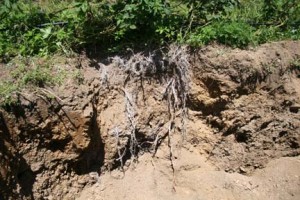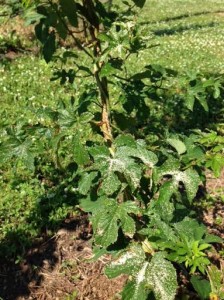Two weeks ago today I had my last day at CLEREL and I already miss it! I had such a great summer filled with amazing people and experiences. I was able to get a hands on feel for research, I gained exposure to hops and grapes, I went to California and collected data in table and wine grape vineyards, I attended an NGWI conference in Napa and met a lot of influential people in the industry, and I started to think more seriously about what my plans should be after I graduate next May.
My last week was devoted to the hops. I collected my leaves on Monday and spent the next few days counting mites. I also borrowed a camera, which I was able to hook up to the microscope and take some photos of TSSM and predatory mites. The photo to the left is a two spotted spider mite, distinguishable by the two black spots on either side of its abdomen. The photo below is a predatory mite and if you look closely, you can see the outline of an egg. It’s hard to determine the species of the predatory mite, as the only difference between species is the shape of the anal plate at the back of the abdomen.
That Thursday, Tim cut down the Brewer’s Gold from the variety row in the hopyard and ran them through the harvester he made. After they went through we still had to pick a lot of the cones off by hand. Tim is still trying to perfect the harvester and make it more efficient than hand harvesting. Some of the bines had male flowers, which are the smaller, almost white flowers next to the cones in the photo below. Once the hops had been harvested, Kim figured out the moisture percentage and how much the hops should weigh when they reach 10% moisture. They were then put into a drying oven, and a sample was weighed periodically until it reached the target weight for 10%  moisture. Kim used a moisture calculator found at the University of Vermont extension website here: https://www.uvm.edu/extension/agriculture/engineering/?Page=hopscalc.html.
moisture. Kim used a moisture calculator found at the University of Vermont extension website here: https://www.uvm.edu/extension/agriculture/engineering/?Page=hopscalc.html.
Today, I drove up to Geneva from Cornell, where I am back in the swing of classes. I met Karen, a woman who works with mites at a lab there, and she helped me identify the predatory mites I had saved on slides. I still have a few to go through, but m ost of the ones I collected are N. fallacis. I did find several tydeid mites, which feed on fungus, not TSSM. Under a microscope they looked distinctly different than the two species I released, which are phytoseiid mites. I will go through the rest of my slides on campus in Ithaca and finish putting all of my data together. I am almost done with my project, and will be ready to present at the Internship Reception in October.
ost of the ones I collected are N. fallacis. I did find several tydeid mites, which feed on fungus, not TSSM. Under a microscope they looked distinctly different than the two species I released, which are phytoseiid mites. I will go through the rest of my slides on campus in Ithaca and finish putting all of my data together. I am almost done with my project, and will be ready to present at the Internship Reception in October.



















